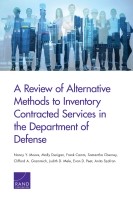| 来源类型 | Research Reports
|
| 规范类型 | 报告
|
| DOI | https://doi.org/10.7249/RR1704
|
| ISBN | 9780833096722
|
| 来源ID | RR-1704-OSD
|
| A Review of Alternative Methods to Inventory Contracted Services in the Department of Defense |
| Nancy Young Moore; Molly Dunigan; Frank Camm; Samantha Cherney; Clifford A. Grammich; Judith D. Mele; Evan D. Peet; Anita Szafran
|
| 发表日期 | 2017
|
| 出版年 | 2017
|
| 页码 | 164
|
| 语种 | 英语
|
| 结论 |
The ICS Falls Short of Meeting Congressional and DoD Stakeholder Needs- ICS data are collected using various methods and data sources, calling into question their accuracy and thoroughness.
- The format in which ICS data are reported to Congress is not useful and hinders the data's potential utility for analyses and decisionmaking. The data also fail to meet the needs of DoD stakeholders responsible for workforce planning and budgetary decisions.
- In its current state, the ICS fails to meet congressional goals, which include strengthening oversight of DoD's contract practices, maximizing the use of competitive procurement processes, improving contractor performance, leveraging buying power, and accurately forecasting DoD labor and budget needs for in-house and contracted services.
There Are Alternative Data Sources for Meeting These Needs- The ICS collects information on contractor direct labor hours, or the time spent working by the contractor employees assigned to the contract, either estimated or provided by the contractors themselves. These data may be inaccurate and fail to support the types of analyses needed for decisionmaking.
- Alternative metrics are at least as accurate and may be produced more quickly and at a much lower cost because they draw on existing data sources.
- Three alternative metrics, in particular, could better inform analyses to support congressional and DoD stakeholder decisionmaking: (1) estimates of civilian labor in the form of full-time equivalents, (2) estimates of contractor labor in the form of full-time equivalents, and (3) estimates of contract employees as a proportion of overall contractor revenue.
|
| 摘要 |
- DoD and policymakers should closely examine the utility of the ICS for the types of analyses they need to conduct to inform budget, sourcing, and other decisions.
- DoD should consider alternatives to ICS metrics that do not require collecting, validating, auditing, and protecting the proprietary data reported by contractors.
- Policymakers should mandate an institutionalized approach to analyzing DoD's spending on service contracts, including analyses of trends, forecasts, and labor.
- Policymakers should refine ICS-related statutory requirements to better distinguish between different types of contracting and provide specific guidance on the data collection needed for each type.
- DoD should periodically and selectively analyze commercial services to determine the lowest-cost and most effective staffing solutions for a diverse set of defense functions.
|
| 主题 | Military Acquisition and Procurement
; Military Budgets and Defense Spending
; Outsourcing
; United States Department of Defense
; Workforce Management
|
| URL | https://www.rand.org/pubs/research_reports/RR1704.html
|
| 来源智库 | RAND Corporation (United States)
|
| 引用统计 |
|
| 资源类型 | 智库出版物
|
| 条目标识符 | http://119.78.100.153/handle/2XGU8XDN/108512
|
推荐引用方式
GB/T 7714 |
Nancy Young Moore,Molly Dunigan,Frank Camm,et al. A Review of Alternative Methods to Inventory Contracted Services in the Department of Defense. 2017.
|
|
文件名:
|
x1495316858590.jpg
|
|
格式:
|
JPEG
|

|
文件名:
|
RAND_RR1704.pdf
|
|
格式:
|
Adobe PDF
|
除非特别说明,本系统中所有内容都受版权保护,并保留所有权利。